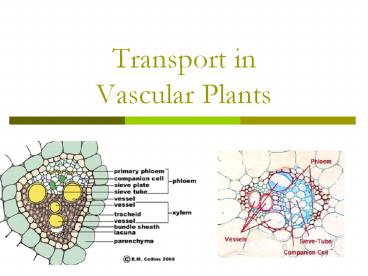Transport%20in%20Vascular%20Plants - PowerPoint PPT Presentation
Title:
Transport%20in%20Vascular%20Plants
Description:
Transport in Vascular Plants Transport in Plants Overview movement of materials from one part of a plant to another involves 2 specialized tissues: Xylem Phloem Xylem ... – PowerPoint PPT presentation
Number of Views:148
Avg rating:3.0/5.0
Title: Transport%20in%20Vascular%20Plants
1
Transport in Vascular Plants
2
Transport in Plants Overview
- movement of materials from one part of a plant to
another - involves 2 specialized tissues
- Xylem
- Phloem
3
Xylem Tissue
- Overall Structure
- made of thick cell walls
- most cells are dead
- cells are stacked up on top of another to form a
hollow tube throughout the plant - Overall Function
- provides structural support to the plant
- carries water and minerals from roots to leaves
- See Table 1 on pg. 555
4
Phloem Tissue
- Overall Structure
- cells are living
- cell walls are porous, allowing exchange of
materials with neighbouring cells - Overall Function
- carries sugars and hormones throughout the plant
- See Table 1 on pg. 555
5
Water Transport in Xylem (1 of 2)
- Roots take in water through the root hairs
epidermal cells by osmosis - Water flows through the epidermal cells, cortex
and into the vascular cylinder which contains the
xylem. - Water is then transported in the xylem tissue up
through the root into the stem and then branches
into the veins of the leaf. It then moves into
various tissues of the leaf such as the palisade
and spongy mesophyll.
6
Water Transport in Xylem (2 of 2)
- Most water exits the plant through a process
called transpiration - The water diffuses into air spaces in the spongy
cells and then diffuses out of the leaf through
the tiny pores called stomata. As each water
molecule exits the leaf, another one enters the
plant through the roots
7
How does a plant move water up from its roots to
its leaves?
- 3 main theories that have been developed to
account for the movement of water in plants - these mechanisms are not mutually exclusive any
or all of these may be at work in a single plant
at any one time - Root pressure
- Capillary action
- Cohesion-tension
8
1. Root Pressure
- Plant roots build up pressure that forces water
upward - Occurs normally in shorter plants
- Pressure built in roots of tall trees wont
really push the water that far up (approx. 1
meter at most)
9
2. Capillary Action (in narrow tubes)
- takes place because of the adhesion of water
molecules and walls of xylem - Adhesion intermolecular force between water and
xylem vessel wall - the finer the capillary or vessel, the higher
water will climb up
10
3. Cohesion-tension
- Also known as transpiration pull
- Transpiration is the evaporation of water vapour
from the leaves through the stomata. - depends on the cohesive forces between water
molecules and adhesive forces between water and
the walls of the vessel
11
Mineral Transport
- By testing the concentration of minerals in the
roots, scientists know that the amount exceeds
that of diffusion - Thus roots are actively pumping minerals and ions
from the surroundings - These minerals are dissolved in the water in the
xylem or roots, which makes it more concentrated - This increases the uptake of water into the plant
12
Translocation Transport in Phloem
- Translocation occurs through the phloem
- Phloem transport is bi-directional
- Most accepted theory mass-flow theory
- Moves from a sugar source (a place where sugar is
produced by photosynthesis or by the breakdown of
sugars) to a sugar sink (an organ which consumes
or stores sugar) - borrows water from xylem to help transport
sugars
13
Transport in Xylem vs. Phloem (P. 569copy into
your notes)
14
Homework
- 1) Copy the translocation diagram from P. 569
onto your handout - 2) Do P. 570 4, 6































